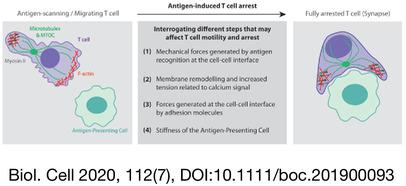当前位置:
X-MOL 学术
›
Biol. Cell
›
论文详情
Our official English website, www.x-mol.net, welcomes your
feedback! (Note: you will need to create a separate account there.)
Mechanobiology of antigen-induced T cell arrest
Biology of the Cell ( IF 2.4 ) Pub Date : 2020-04-27 , DOI: 10.1111/boc.201900093 Mélanie Chabaud 1, 2, 3 , Noémie Paillon 1 , Katharina Gaus 2, 3 , Claire Hivroz 1
Biology of the Cell ( IF 2.4 ) Pub Date : 2020-04-27 , DOI: 10.1111/boc.201900093 Mélanie Chabaud 1, 2, 3 , Noémie Paillon 1 , Katharina Gaus 2, 3 , Claire Hivroz 1
Affiliation

|
To mount an immune response, T cells must first find rare antigens present at the surface of antigen‐presenting cells (APCs). They achieve this by migrating rapidly through the crowded space of tissues and constantly sampling the surface of APCs. Upon antigen recognition, T cells decelerate and polarise towards the APC, ultimately forming a specialised interface known as the immunological synapse. These conjugates form as the result of the interaction between pairs of receptors/ligands that are under mechanical stress due to the continuously reorganising cell cytoskeleton. In this review, we discuss the involvement of mechanical forces during antigen recognition by migrating T cells. We will explore this question from a conceptual and technical perspective, with the aim of providing new insights into the emerging field of mechanobiology.
中文翻译:

抗原诱导的 T 细胞停滞的力学生物学
为了启动免疫反应,T 细胞必须首先找到存在于抗原呈递细胞 (APC) 表面的稀有抗原。他们通过在拥挤的组织空间中快速迁移并不断对 APC 表面进行采样来实现这一点。在抗原识别后,T 细胞减速并朝着 APC 极化,最终形成称为免疫突触的专门界面。这些偶联物是受体/配体对之间相互作用的结果,这些受体/配体由于不断重组细胞骨架而受到机械应力。在这篇综述中,我们讨论了通过迁移 T 细胞识别抗原过程中机械力的参与。我们将从概念和技术的角度探讨这个问题,旨在为新兴的机械生物学领域提供新的见解。
更新日期:2020-04-27
中文翻译:

抗原诱导的 T 细胞停滞的力学生物学
为了启动免疫反应,T 细胞必须首先找到存在于抗原呈递细胞 (APC) 表面的稀有抗原。他们通过在拥挤的组织空间中快速迁移并不断对 APC 表面进行采样来实现这一点。在抗原识别后,T 细胞减速并朝着 APC 极化,最终形成称为免疫突触的专门界面。这些偶联物是受体/配体对之间相互作用的结果,这些受体/配体由于不断重组细胞骨架而受到机械应力。在这篇综述中,我们讨论了通过迁移 T 细胞识别抗原过程中机械力的参与。我们将从概念和技术的角度探讨这个问题,旨在为新兴的机械生物学领域提供新的见解。











































 京公网安备 11010802027423号
京公网安备 11010802027423号